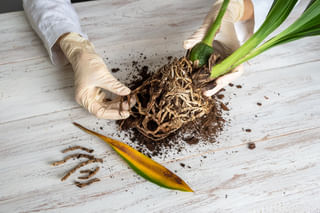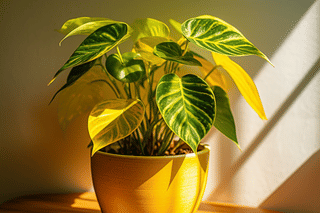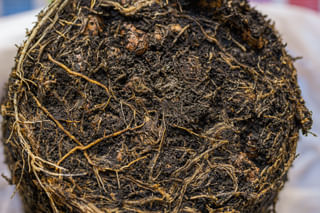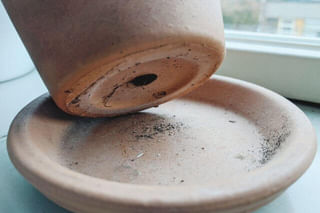How do you recognize root rot on your houseplant?
Learn how to identify and treat root rot on your houseplants. This comprehensive guide provides simple, practical tips for recognizing and addressing this common plant problem. Discover the signs to watch out for and learn effective solutions to help your plants thrive. Let's save your houseplants together!
Have you ever noticed that one of your favorite houseplants looks a little sad? It used to look happy and vibrant, but now it's drooping, has faded colors, and looks like it's slowly drying out, even if you've just watered it. If that sounds familiar, your houseplant might be suffering from a common plant problem known as "root rot".
It's true, most plants love to get watered regularly, on average every 7-10 days, but sometimes even that is too much. If your plant is currently struggling with root rot, don't feel bad. Root rot is one of the most common houseplant problems, and recognizing it is very important to help your plant recover.
In this guide, we'll explore everything you need to know about root root, how to detect it, and most importantly, how to treat it. These are the topics we're going to look at:
Root rot sounds like a very scary problem, but you can still save your plant and help it recover. It's just part of plant care that every plant parent will face at some point. First, let's figure out what root rot is exactly!
Understanding root rot in houseplants

Before we can help our houseplant recover, we need to know what root rot is exactly and why it happens. Having this knowledge on hand for next time will help you to prevent root rot and catch any of these problems early on.
What is root rot?
Root rot is a common problem that can affect plants and is caused by overwatering or a fungus in the soil. The roots start to rot because they get too wet for too long, become soft, and start to rot. When this happens, the roots can no longer absorb the nutrients and moisture they need to stay healthy.
The roots can no longer get the nutrients and moisture they need to keep the plant healthy, so your plant may start to wilt, stop growing, or even lose its leaves. In a later section, we'll look a little more closely at all the other symptoms.
What causes root rot in houseplants?
I've already quickly mentioned that the biggest cause of root rot is overwatering and that fungi can play a role in this too. But how exactly do the roots start to rot from this? When we water our plants, we might be tempted to water them too much. Moist soil is great for most plants, but when the soil is wet and no longer "just moist", it can prevent oxygen from reaching the roots and cause them to drown and rot.
Another common cause of root rot is a fungus present in the soil. This fungus loves the damp conditions, and when overwatering occurs, this fungus will grow bigger and spread out, damaging your plant's root system.
How to recognize root rot in your houseplant
Now that we have a good idea of what causes root rot, it's time to look at how you can learn to recognize root rot and catch any problems early on. If the root rot is in its early stages, you can take action more quickly, which helps your plant to recover much more quickly. So let's learn more about the early signs of root rot.
Early signs of root rot in your houseplant
Root rot can be quite difficult to spot early on, because it has such common symptoms that could mean many different things. Because of this, I'll give you a short checklist you can use to determine if your plant is struggling with root rot or if there is another problem.
Signs that your houseplant may be suffering from root rot include:
- Wilting leaves
- Yellowing or browning of leaves
- A funky smell coming from the soil
- Shriveling and weakening of your plant's stems
If you notice these signs, it could be an early warning that something is wrong with your plant's roots. However, these symptoms look a lot like other plant problems, so let's make sure there is not something else wrong first.
Plant issues that can be mistaken for root rot
Before you say that your plant has root rot, it's important to know that other plant diseases and issues have the same symptoms as root rot.
Pests, too little water, inadequate light, or nutrient deficiencies can cause wilting, yellowing of leaves, and overall plant stress.
Pests
Pests are the easiest problem to check for because you'll see little insects on your plant or you might notice flies flying around your plant. If you do find pests, it's still important to follow along with the rest of this plant care guide, because pests are very attracted to weak plants, including those with root rot.
The plant is too dry
If you don't see pests, check if your plant is too dry. You can quickly tell if your plant just needs more water if the soil is bone dry. If the soil is at least moist, your plant will not be too dry and you can check if your plant needs more or less light.
Improper lighting
If your plant is getting too much sunlight, you might see small burn marks on the stems or leaves. If it's getting too little light, you might notice your plant is starting to lean to one side. It does this to try and get as much sunlight as possible.
Nutrient deficiencies
And last but not least, if you haven't fertilized your plant in at least 6 months, you might start to see wilting. However, if you've recently (in the last 3 months) fertilized your houseplant, you're most likely not dealing with a nutrient deficiency.
Once you've checked these other problems and still think your plant is suffering from root rot, we'll need to check and make sure that's what it is. Let's learn how!
How to check your plant's roots for signs of root rot

Checking your plant's roots for root rot should be done with care to avoid causing further damage. You'll want to gently remove your plant from its pot and shake off excess soil for a clear view of the roots. The roots affected by rot will often look soggy, mushy, and darker than healthy roots. If the rotting has been going on for a while, the roots will probably also have a bad, funky smell.
What does a healthy root vs. a rotting root look like?
If you're growing your houseplant in soil, it might be a little difficult to see a difference in color between healthy roots and rotting roots. The brown soil tends to "stain" the light roots of your plant over time, so it's very likely all the roots of your plant are brown.
The biggest difference between a healthy and rotting root is the texture. A healthy root is strong and slightly fleshy. If you squeeze a root between your fingers, they will stay together. A rotting root, on the other hand, will feel soft and mushy. When you squeeze one of these roots in between your fingers, it'll smear out like a paste.
A healthy root will have a much lighter color than a rotting root. The rotting root, besides being much darker, will appear a little see-through. You can't quite look through it like glass, but it'll be very easy to see through it with a light behind it.
If you're comparing healthy and rotting roots in your pot, it'll be very obvious which one is rotting. Once you've recognized the root rot on your plant, it's time to take action!
Dealing with Root Rot
You've discovered that your plant is suffering from root rot. So now what? Well, first of all, take your plant out of its pot and remove as much of the wet and rotting soil as you can. Be very careful when handling the roots of your plant. You don't want to accidentally damage the roots further.
Trim the rotten roots
Once you've removed the wet and rotting soil from the root ball, it's time to trim off any rotting roots. The usual advice of "Don't trim more than 1/3 of the roots" is going out of the window for this part. There shouldn't be any rotting roots left.
If you happen to leave rotting roots behind it can start to spread again and damage your plant further. Pay close attention to which roots you're cutting, as you don't want to remove any healthy roots. These roots are going to work extra hard to help your plant recover, so be careful not to remove them.
Clean the pot
Now that you've removed the plant from the pot and you've removed all the wet soil and rotting roots, it's time to wash the pot. We've already discovered that fungi thrive in wet soil, so they may be still growing in the pot.
The best way to clean the pot is by using hot water and dish soap or bleach. This will kill all the fungi left in the pot and will give your plant the best shot at recovering successfully.
Replant your plant
Once the pot is clean, you can replant your plant in the pot and add fresh, well-draining soil around your plant's roots. This will prevent accidental overwatering in the future but also give your plant a boost with the added nutrients in the fresh soil.
Usually, when you repot your plant in a new pot, I recommend watering it a little right away to let the soil settle. However, I've personally never done this after replanting a plant with root rot and waiting for a full day before watering my plant. I haven't experienced any issues using this technique, so you can give this a try and see if this works for you too.
Make sure to pay extra close attention to watering your plant for the next few weeks. Only water your plant when the soil is mostly dry. This helps to make the lives of any fungi that were left in the soil after replanting very difficult.
How long does it take for a plant to recover from root rot?
Now that we've covered the steps for treating root rot, you might wonder how long it will take for your plant to recover. The duration largely depends on the severity of the rot and the plant's overall health.
For some hardy and quick-growing species, you might see improvement in just a few weeks. However, if the rot is quite bad or the plant is a slow-growing variety, recovery can take many months. Remember, patience is the key.
Sometimes, even if you've tried your absolute best, your plant can still die. Not all plants can be saved from severe root rot. That's why catching this problem very early is so important. This will give you the best chance of reviving your suffering houseplant.
Best practices to prevent root rot in houseplants
If all goes well, you'll successfully revive your plant that was suffering from root rot. Now you must take care of your plant in such a way that the root rot won't come back in the future. Prevention is the best way to never have to deal with root rot, so let's learn what we can do to prevent root rot.
Preventing root rot is a process, not just an action you can take. To prevent root rot, make sure you have a very healthy plant and you water it only when it needs to be watered.
Proper soil & drainage holes
One of the easiest ways to prevent root rot is to use a pot with drainage holes and by using well-draining soil. This combination makes it (almost) impossible to overwater your plant in the future. The well-draining soil will only hold onto the moisture your plant needs to stay hydrated, but won't hold onto so much that it drowns the roots.
The drainage hole makes sure that any of the excess water that the soil can't hold onto, is removed from the pot. This helps the roots to never stand in a puddle of water.
Water only when needed
Well-draining soil and drainage holes are important, but by far the most important thing to prevent root rot is to only water your plant when the top of the soil is completely dry.
You can make sure the top of the soil is dry by checking it with your finger. If it's still moist, wait a few more days and try again. Underwatering your plant is much less damaging to your plant than overwatering it, so it's better if the plant is dry for a full day than to drown in excess moisture.
Another benefit of the drier soil is that you don't give fungi a chance to settle in the soil and harm your plant.
Fertilize your plant regularly
The last tip I can give you to prevent root rot in your houseplant is to regularly fertilize your plant. This helps your plant to grow and stay healthy long term. The healthier your plant is, the better it can fight off any potential diseases or pests. Fertilizing also helps to replace lost nutrients in the soil, which can be flushed out from overwatering.
However, be careful not to over-fertilize your plant, as this can lead to root burn and further damage the roots of your plant. Always follow the recommended dosage for the type of fertilizer you're using by reading the label carefully.
Thank you for reading this post! I hope it helps you to keep your plants healthy and beautiful! If you're looking for more guides on specific plants, you can always request a plant guide to get a guide for the plant you have trouble with.
Test your plant care knowledge
Quiz completed!
Want to learn more? Sign up for my newsletter to receive free tips in your inbox!
Sign up now!














